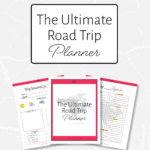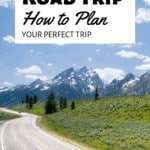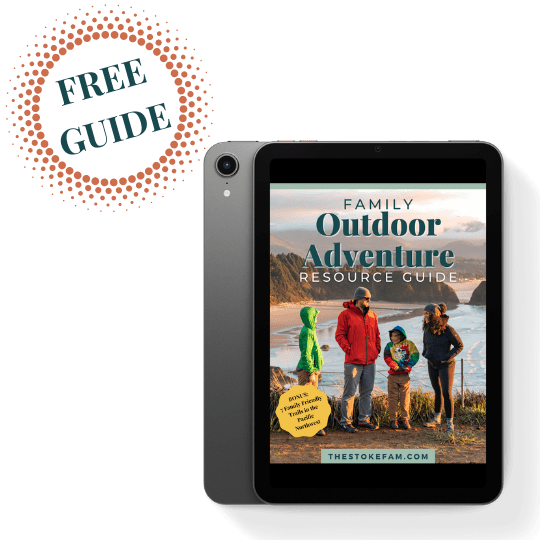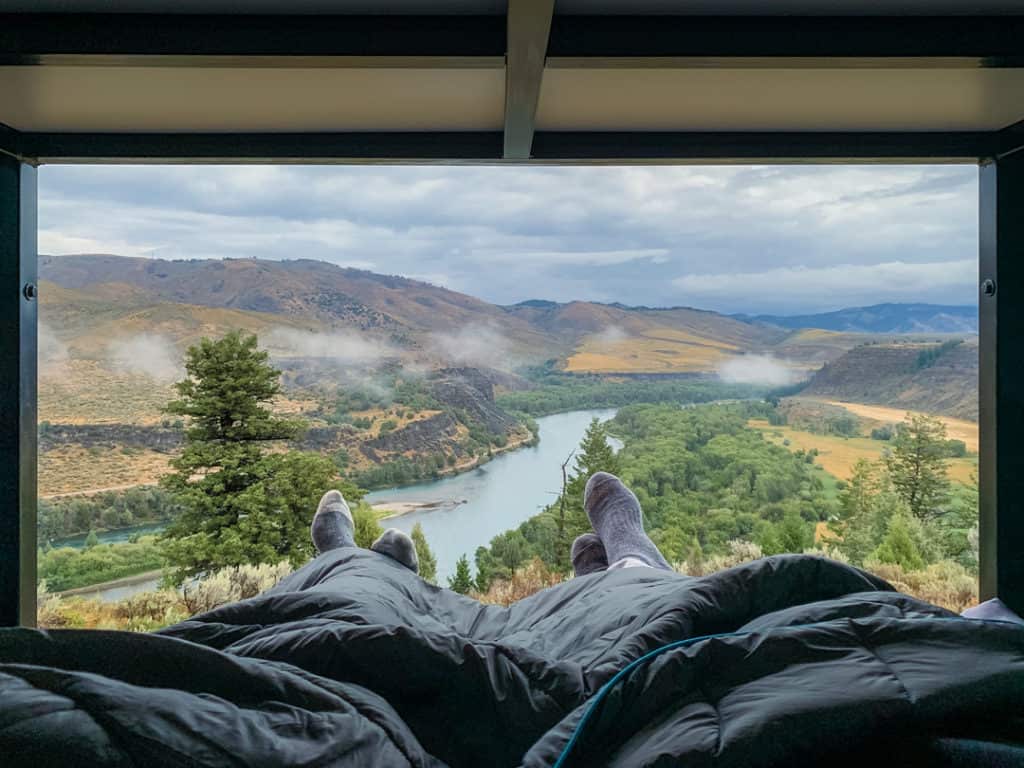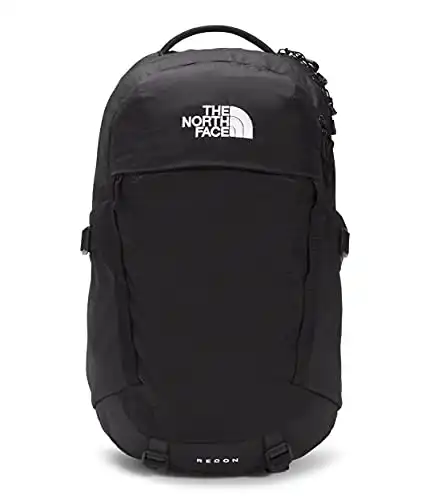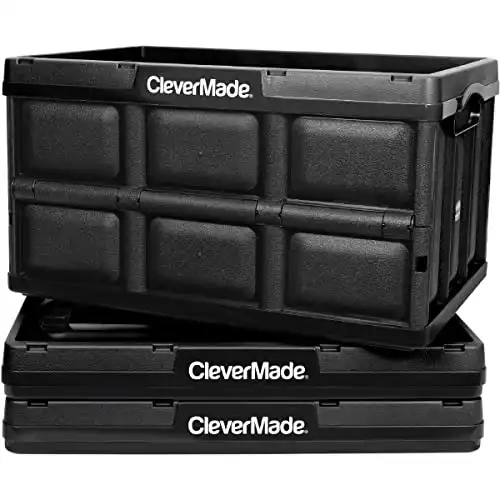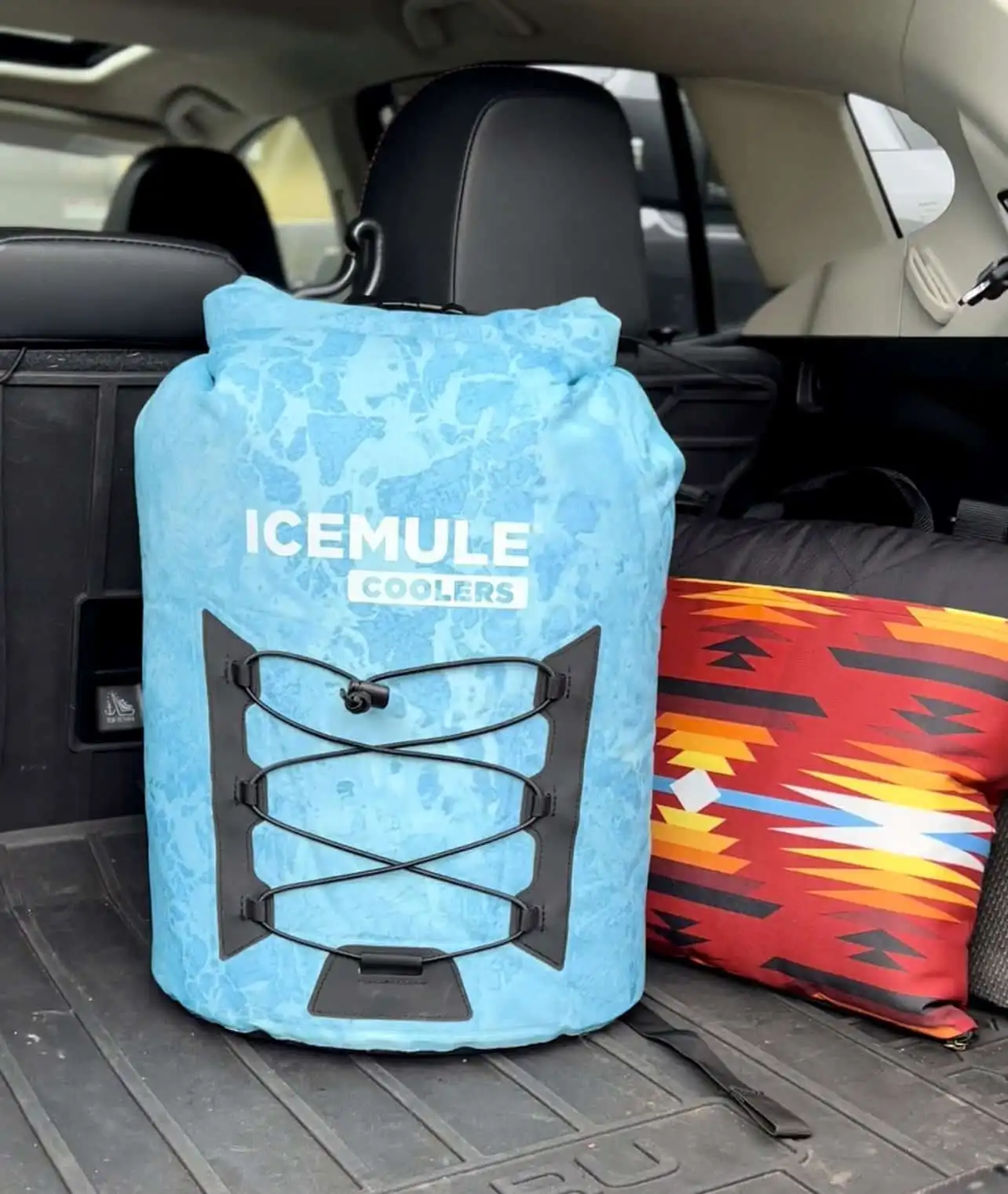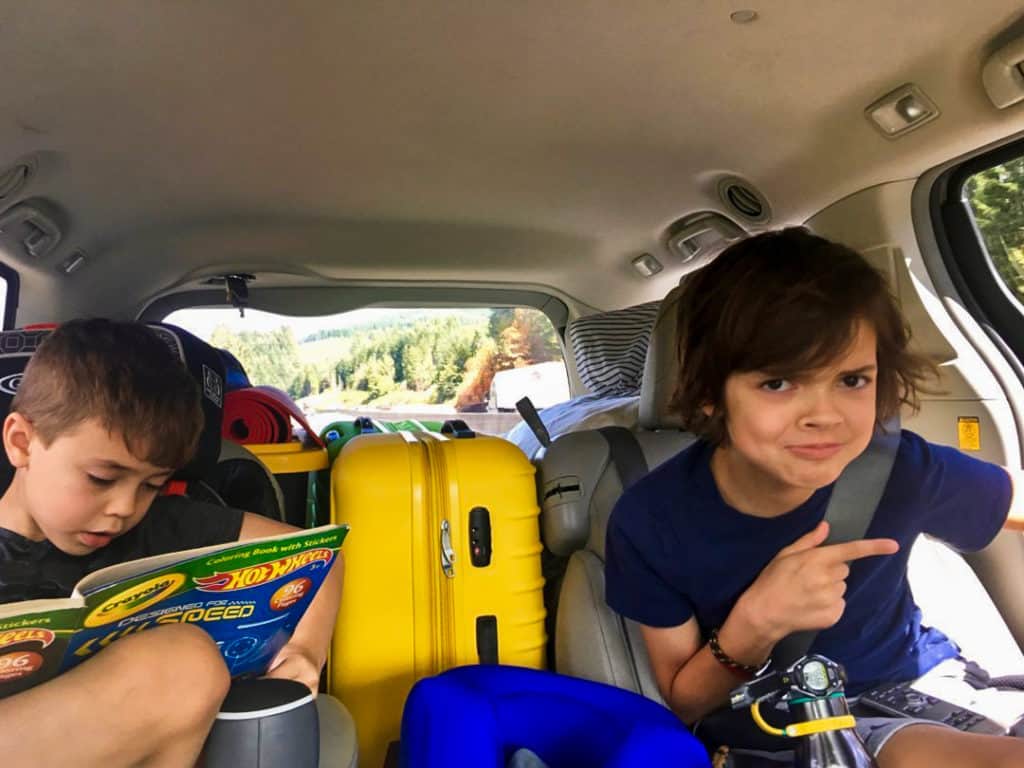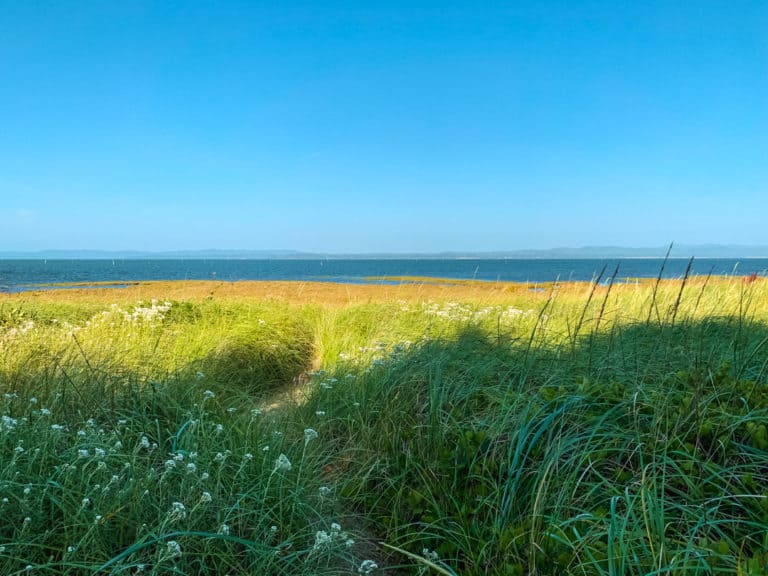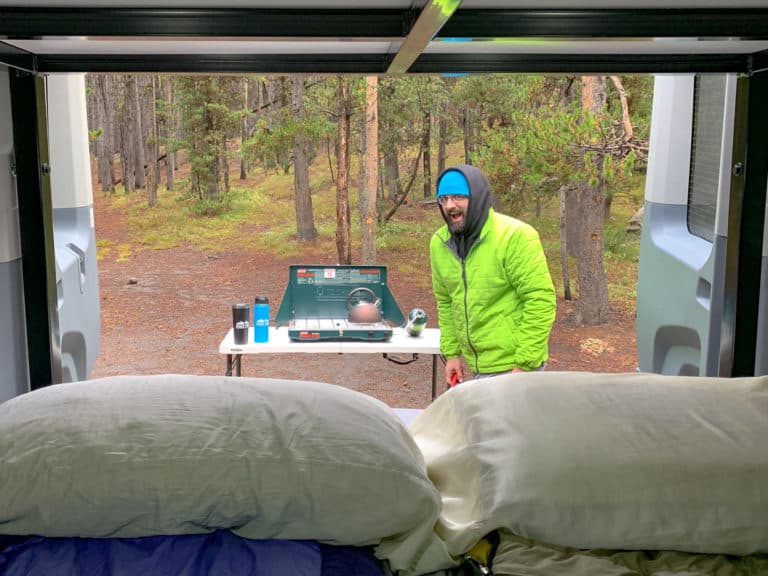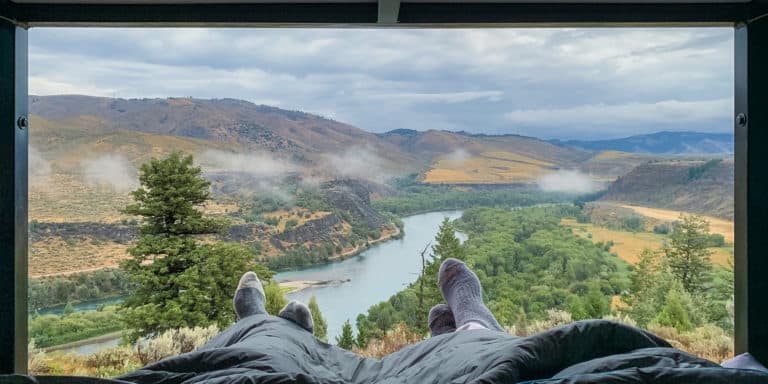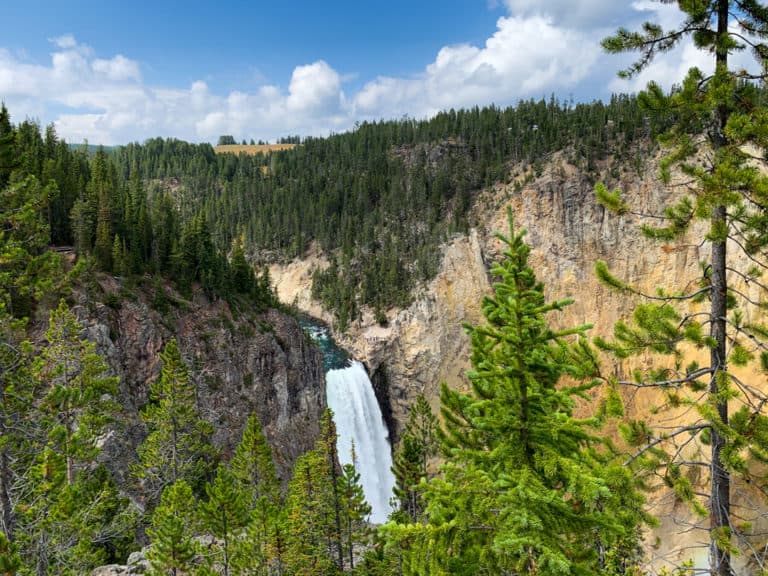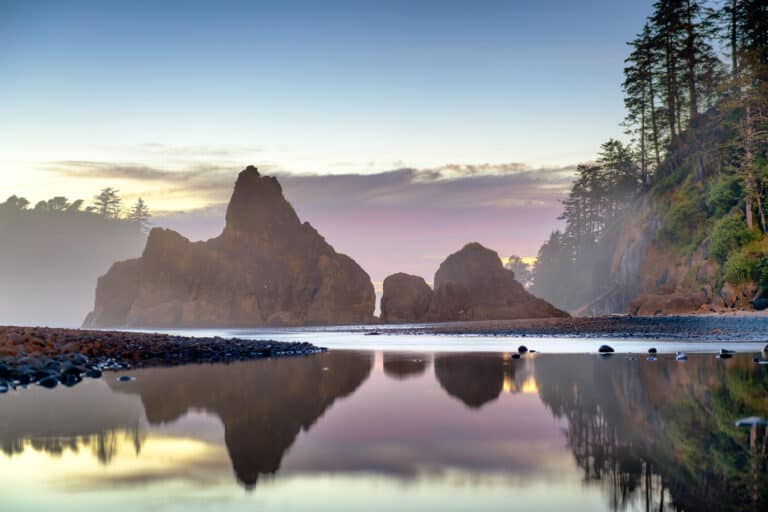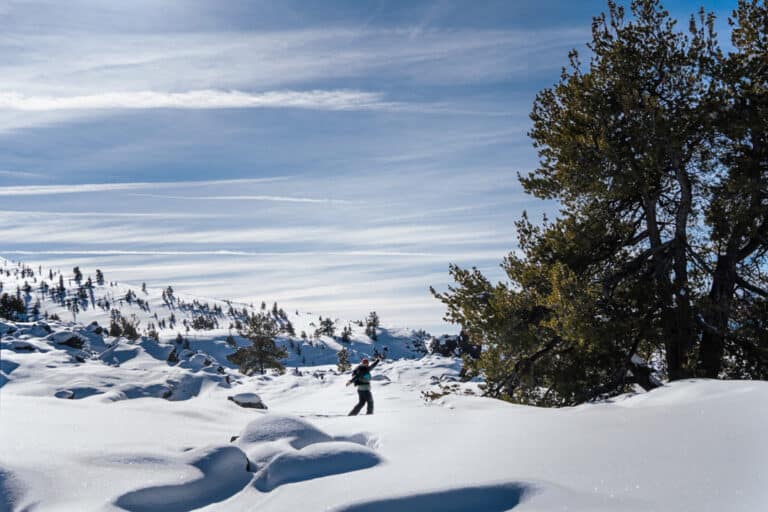Get ready to hit the road because it’s time to plan your next adventure! Road trips are a classic way to explore new destinations, bond with family and friends, and make unforgettable memories. Whether you’re a seasoned road warrior or a first-time traveler, planning a road trip can be both exciting and overwhelming.
But don’t worry, I’ve got you covered! I’m going to walk you through the entire process of how to plan a road trip.
Yes, the same one I once used to plan a 12-day road trip in 2 days. 😅
Over the years, we’ve road-tripped countless times (so we’ve had a LOT of practice). I know the ins and outs of planning the perfect road trip and am stoked to share it with you.
In this article, I’ll guide you through the best way of planning your ultimate road trip step-by-step, from choosing your route and destinations to preparing for emergencies on the road. We’ll also share our best tips for keeping kids entertained, staying safe, and eating well on the road.
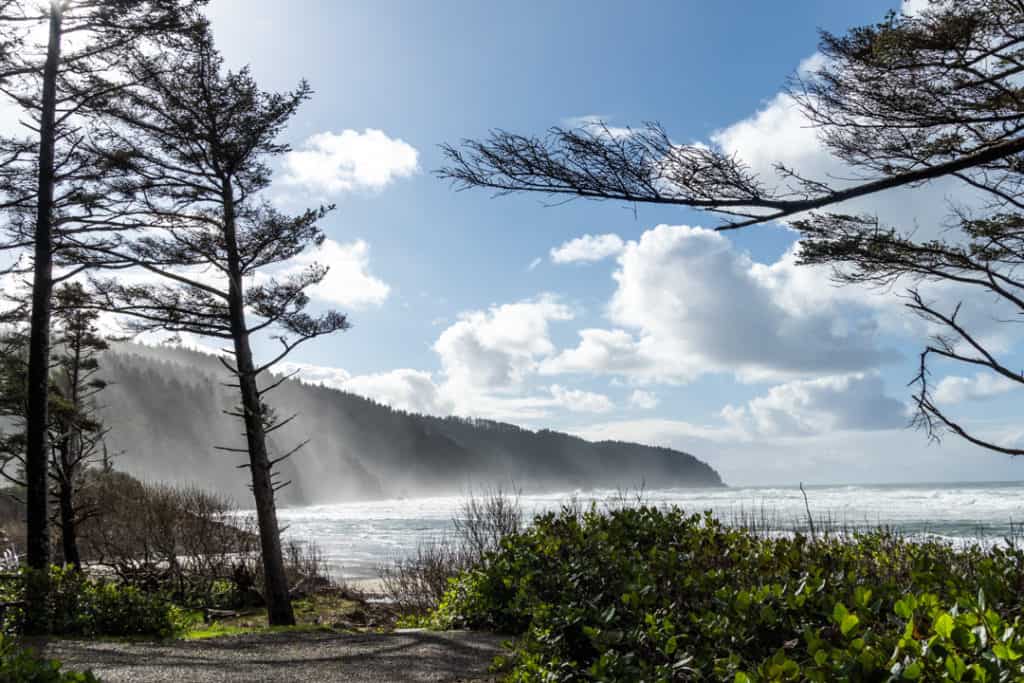
Step-by-Step Guide to Planning a Road Trip
As I’ll share in this article, many things go into planning a road trip. But, if you’re looking for. a quick breakdown, there are a few simple steps to do as you’re planning a road trip.
ROAD TRIP PLANNING STEP-BY-STEP
- Determine the Length of Your Trip and Your Main Destination
- Establish a Budget for the Trip
- Plan an Overview of Your Route
- Research & Identify Key Stopping Points and Must-See Attractions Along Your Route
- Create Your Agenda: Choose Your Travel Dates, Decide How Long to Spend at Each Location, Create a Driving Schedule, and Include Estimated Daily Mileage
- Research and Choose Your Accommodations, Making Reservations as Needed
- Make Sure Your Vehicle is Tuned Up and Ready to Go, Including Emergency Supplies
- Pack for the Trip Based on Your Destination and Activities
- Plan Your Snacks, Meals, Entertainment, and Activities for the Road
- Review Your Plans and Confirm All Reservations Before Departure
Ready to dive into the details? Let’s get started!
Determine the Length of Your Trip
One of the first things you’ll need to know when planning a road trip is how long your trip will be. Whether you have 3 days or 3 months, knowing this is crucial to helping you plan your stops and how long you’ll spend at each.
Planning Your Budget
Another critical piece of planning a road trip is your budget. I’m the first to admit that I’ve been terrible at budgeting and mapping out the entire cost of the trip ahead of time.
I’ve always done an overview of the significant costs – lodging, gas, and estimated major activity costs. But I only sometimes go beyond that. 🫣
Truth be told, budgeting road trips (and other travel) in a more detailed way is something I need to work on. But believe it or not, I’m usually close to our final dollar amount, which is probably why I rarely bother writing it all down. 😆
BUT in the last year or two, I’ve had a more challenging time estimating things as accurately. With costs going up everywhere (especially food!) and two boys entering the teen stage, my ability to guestimate food has been…wildly off, to say the least.
So, I’m improving at planning and tracking our spending during our trips.
And in case you’re in a similar boat, I’ve put together a Road Trip Budget Planner & Tracker within The Ultimate Road Trip Planner to help you track how much money you can (and do) spend.
Choosing Your Main Destination & Route Overview
Picking a route for your road trip is like choosing toppings for your pizza – you want it to be just right. It’s the foundation of your journey, and getting it right can make all the difference in creating an unforgettable experience.
To start, determine your general location (i.e., Pacific Northwest) and your endpoint (where you’ll spend the most time OR turn around to make your way home). Even though we’re calling it your endpoint, it’s your starting point for planning.
This is typically the primary destination for your trip – most likely the one that made you start planning a road trip in the first place.
Once you’ve decided on your main destination, take a peek at maps and look at the different routes you could take to get there and back.
You can take a different route each way to see more. (We do this all the time!) To see as much as possible, explore your routes and what you can see along each…are there any destinations that stand out?
For instance, when we planned our California road trip with Legoland as our final destination, we knew we wanted to make sure we stopped in Monterrey for the aquarium. Still, we also wanted to make sure to see Yosemite. So, we traveled down the Pacific Coast Highway and back up via National Parks.
However, if time is of the essence, you can skip this part and pick the straightest shot.
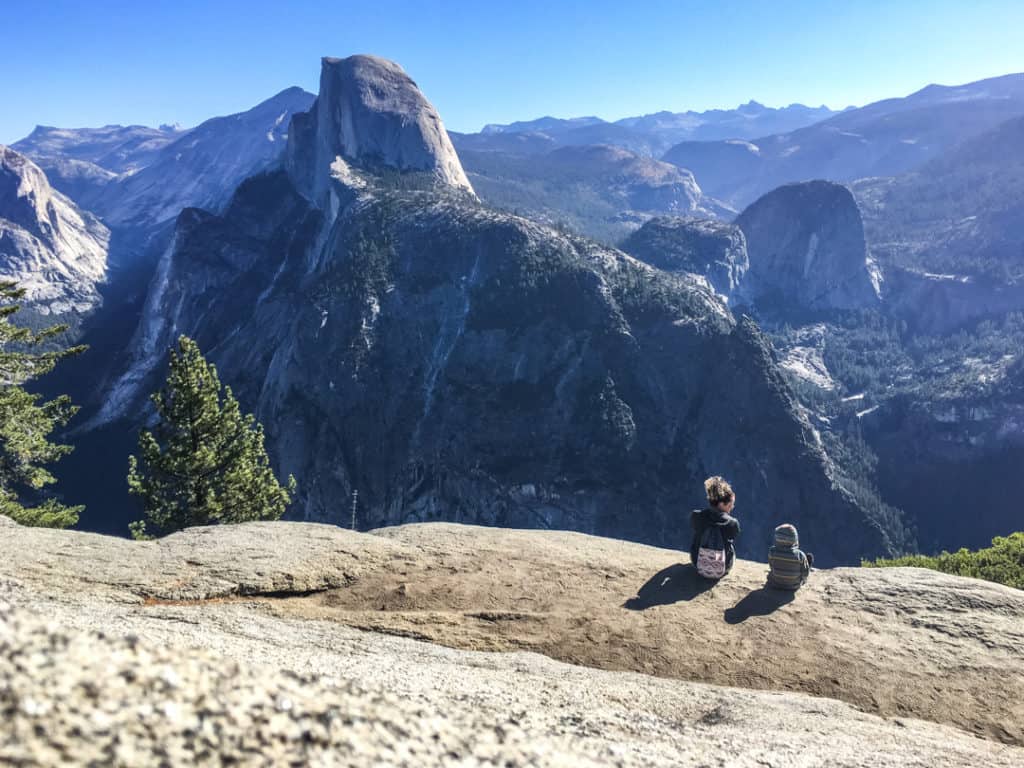
Picking Stopping Points and Must-See Attractions
After you have your main route overview planned, comes the fun part. Start by looking along your route for cool places to stop.
We typically start by looking for National Parks, State Parks, and places we’ve had on our bucket list. Then, I’ll scout additional locations by reading blogs and searching Pinterest and Instagram.
Along your route, make a note of the places you want to see most, highlighting your top three stopping points. This will help you create a loose itinerary and show you how to piece the rest of your trip together.
Planning Your Schedule
Now that you’ve got a general idea of where you’re going, it’s time to add more details to your road trip itinerary.
First things first, plan for the unexpected. Leave a little wiggle room in your itinerary to account for flat tires, impromptu roadside attractions, and those inevitable bathroom breaks.
Next, set reasonable daily driving limits based on your preferences and travel style. Some folks drive for hours without stopping, while others prefer shorter drives with more frequent breaks. Figure out what works best for you and your fellow road trippers.
Finally, allow a bit of extra time for rest and relaxation. You want to make the most of your trip without overdoing it. If possible, plan to kick back and enjoy your surroundings for an afternoon or a day or two.
As I’m planning, I always start by asking myself the following questions.

Road Trip Planning Questions to Ask Yourself
Using all of these details, start piecing together your agenda. I like to start by filling in our top destinations first. Then, I calculate the drive time and estimated mileage between each. With the time we have left, I determine how long we can spend at each location and fill in any extra stops, if possible.
Planning a Road Trip with Multiple Stops
Road-tripping is one of the best ways to explore new places and make unforgettable memories. As you’re planning a road trip with multiple stops, the process is much the same, but you can do a few things to ensure it goes smoothly.
- One of the most important things to remember when planning a multi-stop road trip is to stay flexible. You never know when you might encounter an unexpected attraction or spend more time in one place than you originally planned. Allow yourself wiggle room in your schedule to account for changes.
- Next, in many cases, you’ll want to research and book accommodations ahead of time. This will typically save time and money and ensure you have a comfortable place to rest at the end of each day. Consider booking refundable accommodations to allow for last-minute changes to your itinerary. Alternatively, you can choose to secure your reservations as you go, but this can be a bit more risky.
- Finally, make a packing list to ensure you have everything you need for each activity and stop. I like to include clothing for the weather and activities we’ll experience and any gear or equipment we might need. Plus, we’ll always pack snacks, drinks, entertainment options, and necessary safety and emergency items.
Booking Your Accommodations
After you have a tentative agenda with dates and stopping points, it’s time to start choosing and booking your accommodations! There are several ways to do this.
Sometimes, such as when we planned a California road trip, we book our nights at our main destination (this time, the Legoland Hotel) ahead of time but wing it on the remainder of our bookings to give us some flexibility. Other times, we’ll book everything before we leave.
But, no matter when we book, I start by doing research on a variety of websites and apps to help us find the best options and deals along our route.
Here are some of our favorite places to book accommodations:

Our Top Picks for Booking Hotels & Vacation Rentals

Our Top Picks for Booking Campsites

Tip: When it comes to reservations, I prefer to have our confirmation number somewhere other than my email. We’ve been caught with little to no signal, trying to pull up booking info. 😅 It’s just not worth the stress.
Whether you copy your confirmation into your Notes app, take a screenshot, print your confirmation email, or jot it down in your Details & Accommodations page in our Road Trip Planner, it can save a lot of stress at check in.
Preparing Your Car
This isn’t the fun part of getting ready, but it can save you a LOT of headaches in the long run.
Before hitting the road on your trip, it’s crucial to check your car. Nobody wants to be stranded on the side of the road with a flat tire or a dead battery – especially when traveling with kids.
First, ensure your car is in good working order, and you don’t have any lights on your dashboard that you’ve been ignoring. 😅 Check your tires for any signs of wear and tear, and ensure that they are properly inflated and that you have your spare. It’s also important to check your brake lights, headlights, and taillights. You don’t want to be caught out with a burnt-out bulb while driving at night.
We typically make sure we’ve had a recent oil change, filled the washer fluid, and rotated the tires before going on a road trip. If we leave early in the morning, we will top off our gas tank the night before to make getting out of town easier.
Before leaving, pack emergency items such as a first-aid kit, tire repair kit, and other necessary tools. We also like to ensure we always have a set of jumper cables. These items can be lifesavers when you’re in a pinch.
Also, check your car’s oil level, washer fluid, and coolant. If you have a diesel, it’s also a good idea to top off your DEF. And, if you’re coming up on an oil change or any other service, it’s best to get it done before hitting the road.
If our plans include any travel off the main roads onto gravel or Forest Service Roads, we also bring our air compressor. This lets us air down for a smoother ride (and less chance of a popped tire) but air back up when we get back to the main roads.
Staying Organized on the Road
Packing for a road trip can be much different than packing for a short car ride or airplane travel. When you spend hours or days on end in the car, your entertainment and snack game needs to be on point.
And, as someone who has been on my fair share of road trips, I know staying organized is key. Who wants to have to pull over to find that one must-have toy or favorite snack? Not me, that’s for sure.
I recommend using bins, backpacks, and other organizational tools to keep things tidy. That way, everything has a designated spot and is easy to find when needed. Plus, it helps to keep your car clutter-free and more comfortable for everyone.
And speaking of comfort, it’s also a great idea to bring a favorite pillow or blanket for those long stretches of driving (especially at night).
Our organization system on the road typically looks something like this:
Car Packing Tips
Personal Backpacks
We have each kid pack their own backpack full of entertainment and any special items they want to bring.
Entertainment Bin
I also typically pack a bag or bin with additional books (we love taking books about the area or wildlife we’ll see) and a few small surprises. This can be anything from new coloring books to fidgets to games that can be played in the car. The dollar store, Target, or Amazon are my go-to spots for finding inexpensive items to keep little hands busy.
Snack Bin and/or Cooler Bag
We also like to keep a bag or bin of snacks just behind the front seats so they are easy for everyone to grab and to minimize extra stops. Especially on longer trips, I also like to add a cooler bag like this one. We love having cold drinks and snacks, such as cheese sticks, fruit, veggies, and hummus on hand.
What to Pack for a Road Trip
Packing for a road trip can be a challenge. You want to remember everything important but also avoid overpacking and ending up with a cramped car. 😅
Fear not, my road-tripping friend. I’ll help you learn to pack like a pro. To help you out, here is a list of key items to add to your road trip packing list:
Essential Items:
- Driver’s license, car insurance, registration, and any other necessary documents
- Road atlas or paper map (in case you lose cell service)
- Emergency contact information
- Cash and credit cards
Comfort and Convenience Items:
- Pillows and blankets for a cozy nap
- Sleep eye mask (optional)
- Neck pillows for added comfort
- Sunglasses and hats to protect you from the sun
- Snacks and drinks for the ride
Clothing and Shoes for Various Weather Conditions:
- Layers for temperature changes
- Rain jackets and umbrellas for rainy days
- Comfortable shoes for walking and hiking
Toiletries and Personal Care Items:
- Toothbrush, toothpaste, and floss
- Deodorant, soap, and shampoo
- Hand sanitizer and wet wipes for cleaning
- Feminine hygiene products, if needed
- Toilet paper (just in case!)
- I also like to take a female urination device, like the Tinkle Belle – it’s come in handy more than once!
Tech and Electronics:
- Chargers and portable battery packs for your devices
- Headphones for quiet time or to listen to music or audiobooks
- Cameras and memory cards to capture the memories
Outdoor Gear and Equipment:
If you’re planning to camp along your trip, be sure to pack your camping gear. Even if you’re not planning a night at a campsite, you may still want to pack some of these. For instance, we typically take our camp chairs and a portable stove to make a quick meal anywhere.
- Tents and sleeping bags for camping trips
- Camp chairs and a portable table for outdoor dining
- Coolers and ice packs for keeping food and drinks cold
- Portable stove and fuel
- A couple of easy meals that you can make anywhere (i.e., ramen, beans and rice, etc.)
First Aid Kit and Medications:
I can’t tell you how many times a basic first aid kit in our car has saved us. Whether for scrapes, bug bites, or other minor injuries, we always carry one along with essential medications in our vehicle.
- Basic first aid supplies such as bandages, antiseptic wipes, over-the-counter medications, and gauze
- Any prescription medications you or your travel companions require
Related: Download our Road Trip Planner for a printable packing list!
Snacks and Drinks for the Road:
Always, always, ALWAYS travel with snacks.
It’s sometimes the only thing that keeps us sane on a road trip with kids.
We always pack fresh fruit like apples or oranges, allergy-friendly snacks, and crackers. We also like filling a cooler with small, healthy items like baby carrots, hummus, and cheese sticks.
We started doing this years ago because one of our kids had a severe food allergy, making stops at some restaurants unfeasible. He’s since outgrown the allergy, but we kept up with the snacks and drinks on the road because it’s so convenient.
Our goal is always to keep the fast-food stops to a minimum and have some healthy options on hand.
- Fresh fruit, granola bars, and other healthy options
- Chips, candy, and other treats for indulging
Related: Make Life Easy with These Allergy-Friendly Pocket Snacks
Roadside Emergency Kit:
When it comes to a roadside emergency kit, you can purchase a complete kit or assemble your own, including items like these:
- Flashlight and extra batteries
- Jumper cables
- Tire gauge and tire repair kit
- Multi-purpose tool or a pocket knife
- Reflective warning triangles or flares
For winter road trips with a possibility of snow, we also travel with:
- Chains
- Snow shovel (a folding version like this saves on space)
- Traction boards
- Windshield washer fluid with de-icer
- Ice scraper
- Additional layers, including blankets or sleeping bags, gloves, coats, warm socks, and snow boots.
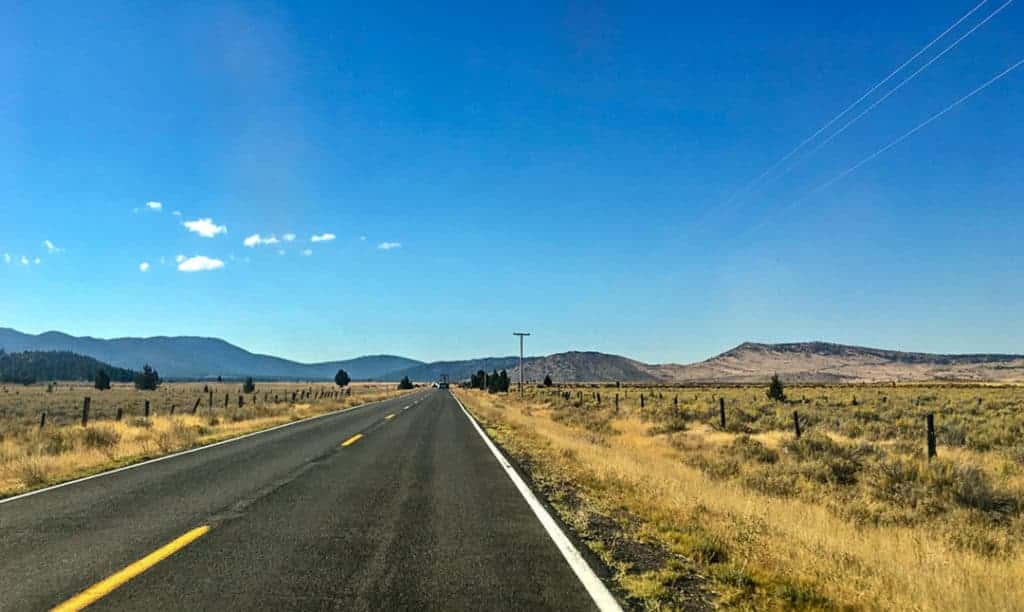
Best Road Trip Planning Tools: Plot Your Adventure Before You Hit the Road!
If you’re anything like me, you’d rather be a passenger princess than glued to the maps every five seconds. 😜Thankfully, this is where road trip apps come in. Apps like Google My Maps and Roadtrippers can help you navigate like a pro, providing helpful information on attractions, restaurants, and gas stations.
Before you hit the pedal to the metal, let’s talk about planning your road trip. As you start putting together all the details of your journey, you’ll need an easy way to organize it all. But don’t worry. I’ve got you covered with the best road trip planning tools to help you make the most of your adventure.
Roadtrippers: The Ultimate Trip Planner
Roadtrippers is the ultimate tool for plotting your epic road trip. This website (and mobile app!) helps you plan your route, discover new destinations, and find interesting places. You can even filter by category (outdoor activities, scenic drives, weird attractions… you name it!).
We love that Roadtrippers helps us automatically find the most efficient route, has roadside attraction suggestions, and we can create trips with up to 150 stops and download the maps for offline access with the Plus plan. This is especially helpful if traveling in remote areas – or even within many National Parks! Plus, Roadtrippers lets you save and share your itinerary with your travel buddies.
You can find out more here and use code: STOKEFAM and code for $5 off your upgrade. Even if you don’t upgrade, the free version offers many excellent road trip planning features! See how we use the Roadtrippers app to plan our adventures.
Here’s how it works:
Google My Maps: The Collaborative Planner
If you’re more of a Google person, you’ll love Google My Maps. This tool lets you create custom maps, add notes and recommendations, and share them with your travel friends. We love the ability to use map layers to help organize your points of interest and plan the best things to do.
Plus, it’s easy to collaborate with others. So if you’re road-tripping with friends or family, everyone can pitch in and add their favorite spots to the map.
The Ultimate Road Trip Planner: Printable Road Trip Planner
Planning a road trip can be overwhelming, but it doesn’t have to be! Our printable road trip planner is here to make the process easier and more organized.
It includes an overview section to help you map out your route, accommodation details to ensure a comfortable stay (and that all the important stuff is handy), and a packing list to ensure you remember the essentials. Additionally, it has sections for budgeting, daily agenda, and brainstorming, so you can have everything you need in one place.
I’ve also included Road Trip Bingo and Trip Journal pages for the kids to help keep them entertained during the drive. 🙌
By using The Ultimate Road Trip Planner, you can reduce stress and focus on creating unforgettable memories with your loved ones. So, whether you’re planning a long-awaited family vacation or a spontaneous road trip with friends, our printable road trip planner is the perfect tool to ensure you’re fully prepared for the adventure ahead.
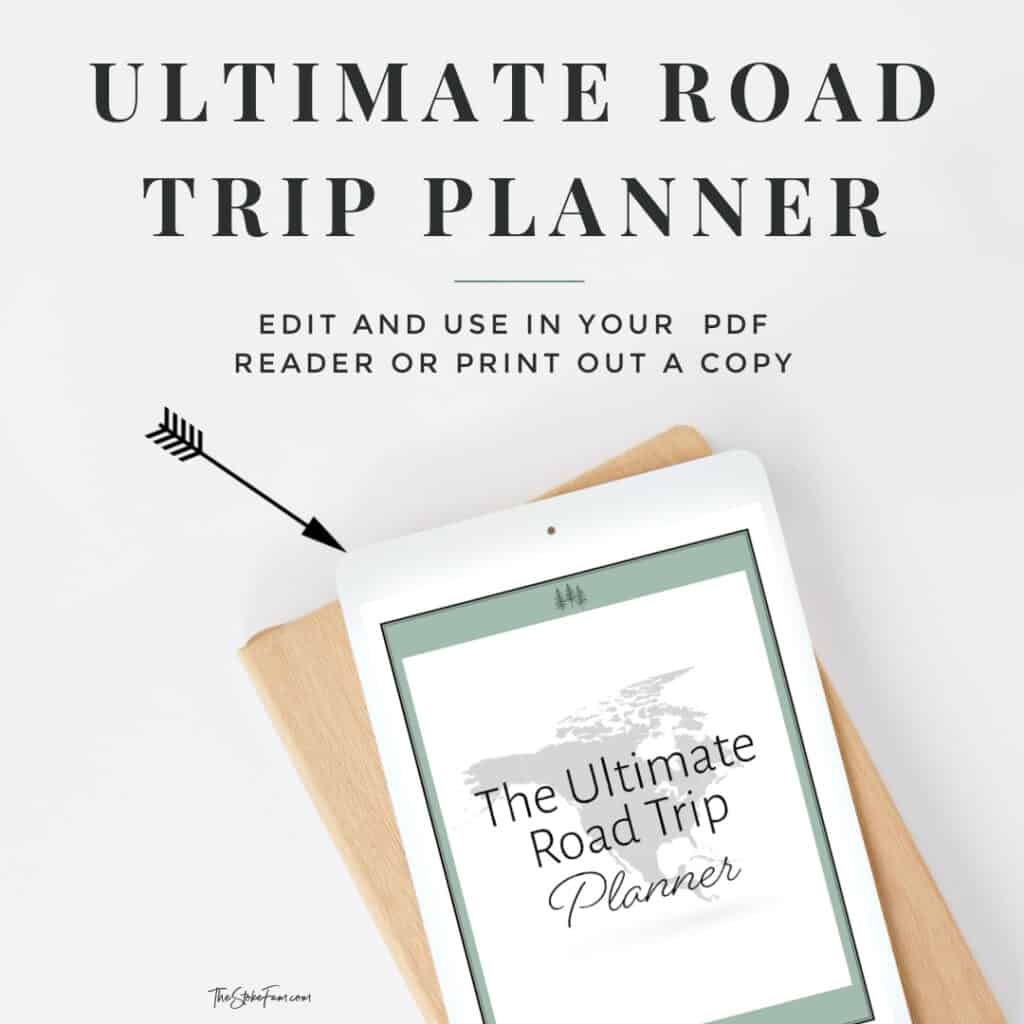
Other Options to Consider
While Roadtrippers and Google My Maps are fantastic tools, there are many options like Furkot, MapQuest, and even good old-fashioned paper maps. Find what works best for you, and don’t limit your creativity!
Best Road Trip Tools and Apps to Use On the Road
As much as the journey itself, the tools and apps you use during your trip can make or break your road trip. Here are some must-have road trip tools that can help you navigate, stay entertained, and stay safe.
Entertainment Apps
Long drives can be boring, but apps like Spotify, Netflix, Overcast, and Audible can entertain you and your passengers for hours. Whether you want to listen to music, watch a movie, or listen to an audiobook or podcast, these apps offer endless entertainment options.
Game Apps
Game apps are a great idea when you’re looking for a bit more interactive fun during a road trip! There are many options, but a few ideas to get you started are:
GasBuddy
When you’re road-tripping, fuel costs are a massive part of your budget. GasBuddy is one of our favorite tools to save as much moolah as possible by showing you crowd-sourced rates for fuel along your route. You’ll see when the rate was last updated as well, so you know if it’s likely to be accurate (for instance, if it was updated today, it’s usually spot on, but if it’s been a couple of weeks, the price may be different).
Drive Weather
Drive Weather is a handy tool that helps you know what’s coming along your drive. It shares details about the weather along your route based on your departure time – how cool is that?! It’s a great way to know if you’ll likely encounter bad weather as you travel. If things look severe, you can always build in additional stops or change your route.

Road Tripping with Kids
Road-tripping with kids can be an adventure, to say the least! 😜 But with a bit of planning and patience, it can also be a fun and memorable experience for the whole family.
Here are some tips for road-tripping with kids:
Games and Activity Ideas to Keep Kids Entertained During a Road Trip
When it comes to entertainment on a long road trip, you can never have enough when you’re traveling with kids.
Seriously.
Our kids typically do really well on road trips. Still, sometimes an activity I think will entertain them for an hour, they abandon after 15 minutes. 🤷♀️ This is why you will find us with a wide variety of activities when we travel.
Here are some of our favorite game and activity ideas to keep your little ones entertained on the road:
Classic Road Trip Games
- I Spy: A game where someone chooses an object within sight and gives the other players a clue by saying, “I spy with my little eye something that is…” and then describing the item based on its color, shape, etc. The other players take turns guessing the object until someone guesses correctly.
- 20 Questions: One person thinks of a person, place, or thing, and the other players take turns asking yes or no questions to try and guess what it is within 20 questions or less.
- License Plate Game: Players try to spot license plates from different states and keep track of how many they find.
Digital Options
We live in a digital age, so while we try to balance electronic use during a road trip, there are some advantages! Load up on some kid-friendly apps, fresh podcasts & audiobooks, or movies for a smooth ride.
You can also try kid-friendly gaming apps like Mad Libs, Trivia Crack 2, Rory’s Story Cubes, and Heads Up!
If you’re going to toss all your screen time rules out the door during the trip, then no worries. You do you!
But if you’re hoping to maintain some of your normal routines, we’ve had luck with these road trip screen time strategies.
- 30 minutes of reading or creative activity before every 30 minutes of electronics.
- Setting a screen time limit and letting the kids know how long we will be in the car for the day. Then, we allow them to choose how they want to use it. For instance, if we are driving for 6 hours, but their max is 2 hours, we let them decide how to break it up. This one works best for older kids who can self-regulate a little.
- Exhausting every non-electronic option before allowing the opportunity. We’ve knocked out entire 5-6+ hour drives by having a lot of creative activities before we had to resort to screens.
Creative Activities
Encourage creativity and imagination by bringing some coloring books or Mad Libs. Who knows what kind of hilarious story you’ll create together!
Some of our favorites to pack are:
- Paper and markers or crayons for drawing
- Activity books
- Paper Crafts like these folding robots or origami paper
- Road Trip Bingo (grab a free printable version in our road trip planner)

Safety Tips for Road-Tripping with Kids
We’ve been road-tripping with our kids since they were tiny and we love it! But, one of the most important things about traveling with kids is ensuring their safety. Here are a few tips to keep in mind:
Chow Time: Road Trip Food for Families on the Go!
Other than “Are we there yet?” the most common thing we hear on road trips is “I’m hungry.” 😅Needless to say, a family road trip is not complete without some delicious snacks and meals to keep everyone happy and energized. Here are some tasty and healthy food options for families on the go:
Snack Smart
Road-tripping with kids doesn’t mean you have to ditch healthy eating. Pack fruits, veggies, trail mix, and granola bars for guilt-free munching. Here are some quick, healthy snack ideas:
- Fruits and veggies: Chop carrots, celery, and bell peppers for a healthy, crunchy snack. Apples, bananas, and grapes also make great on-the-go snacks.
- Trail Mix: Combine nuts, seeds, and dried fruits for a sweet and savory snack that will satisfy you between meals.
- Cheese and crackers: A classic snack that’s easy to pack and provides a good source of protein and calcium.
Grab-n-Go
On-the-go meal options like sandwiches and wraps can be lifesavers when hunger strikes. Make them ahead or grab ’em at a local deli or grocery store and pop them in your cooler for when the craving strikes.
- Sandwiches and wraps: A sandwich or wrap can be customized to everyone’s liking and is easy to eat in the car. Pack some whole-grain bread, lean meats, and veggies for a quick, nutritious meal.
- Pasta salad: Cook some pasta and mix it with veggies, cheese (if you like), and a light dressing for a refreshing and filling meal.
- Hummus and pita: Hummus is healthy and flavorful and pairs well with pita bread and veggies.

Dealing with Roadside Emergencies
No matter how well you plan, sometimes things go wrong on the road. From a flat tire to a dead battery, it’s important to be prepared for any roadside emergency.
Here are some tips to help you handle unexpected situations:
FAQs About Planning a Road Trip
Is there an app to plan a road trip?
Yes! There are several of them. Two of our favorites are Roadtrippers and Google My Maps.
Can Google Maps help you plan a road trip?
Absolutely! We suggest Google My Maps to help you plan and break things down by day and activity type.
How often should you stop on a road trip?
It can vary depending on your group, but a good rule of thumb is to stop approximately every two hours. You can vary your stops between rest stops, parks, restaurants, or even hikes. But stopping frequently allows everyone to stretch their legs, use the restroom, and stay alert.
Staying Flexible
Ultimately, being flexible is the most crucial part of learning how to plan a road trip.
Whether it’s that your ideal hotel is booked, that you run into a traffic jam, or that your kids are starving EVERY FIVE MINUTES, there are going to be some things that require flexibility. If you go into it with that expectation, dealing with the changes will be much easier.
But, sometimes, being flexible just means allowing for spontaneity and making memories that last.
You may come across a roadside attraction you can’t miss.
Or, you find the perfect spot to stop and watch the sunset.
Allow yourself the flexibility to adjust your plans for your perfect road trip, and you’ll be sure to remember your experience for a lifetime.
Final Thoughts About How to Plan the Perfect Road Trip
Now that you’ve planned your trip and are armed with all the tips and tricks for a successful road trip, it’s time to hit the open road and make some unforgettable memories. But, before you head out, it’s a good idea to take a few moments to review your plans and confirm reservations to avoid any surprises.
Planning for a road trip is key, but remember to enjoy the journey. And don’t be afraid to take detours or stray from the beaten path – some of the best road trip memories are made off the grid!
Whether you’re road-tripping with family, friends, or even solo, there’s something magical about the freedom of the open road. So pack your bags, grab some snacks, and hit the gas pedal. Adventure awaits!

